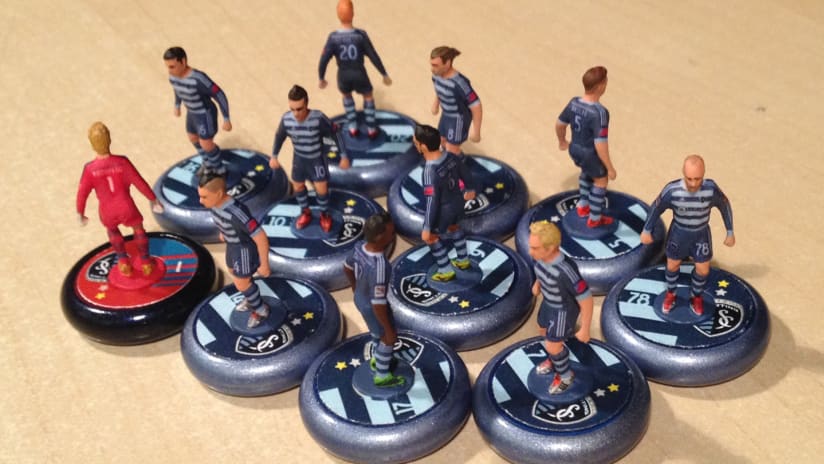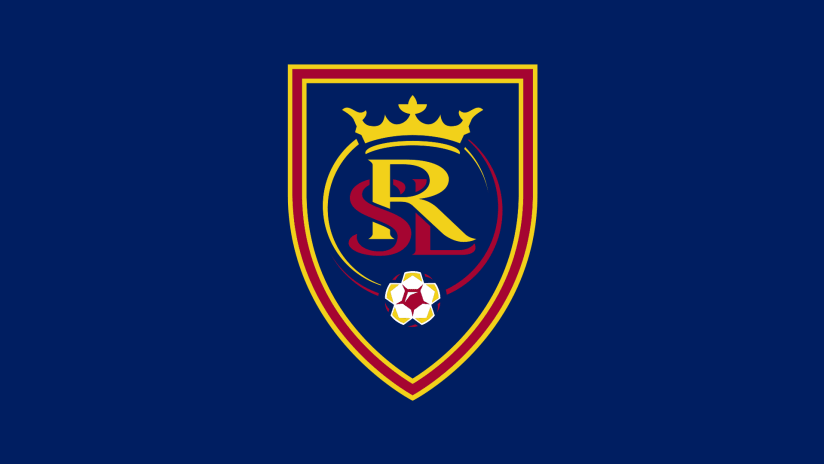Jeff Drake lives in St. Louis, but he loves Sporting Kansas City — and boasts one of the more unusual tributes to the team inside his house.
First, there’s a table that looks like a foosball table with the rods removed, with a green soccer pitch atop it that’s not quite felt, and not quite turf, either. The side railing on the table is branded “Sporting Park" (SKC's stadium name before it was Children's Mercy Park), and the whole thing comes complete with signage celebrating the team’s two MLS Cups. There’s even a miniature Cauldron scarf on the rail’s field-facing side, behind one of the corners.
Then, there are the replicas of players, standing less than an inch high on round, flat platforms that look like curling stones. Drake’s setup features the starting 2012 lineup, including goalkeeper Jimmy Nielsen in his distinctive pink ’keeper’s kit.
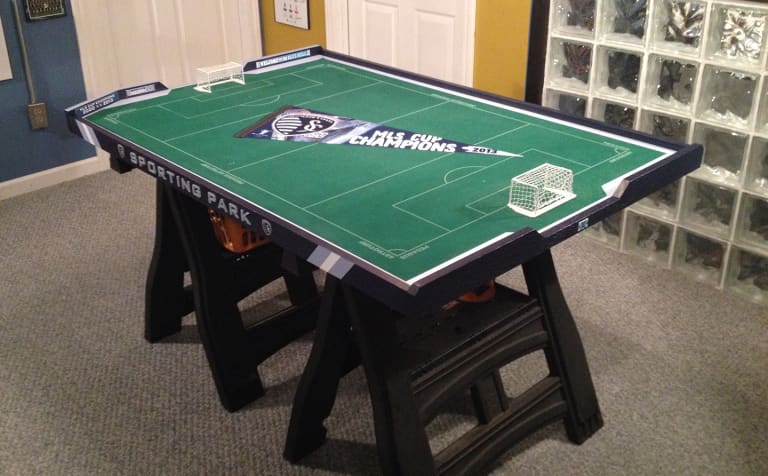
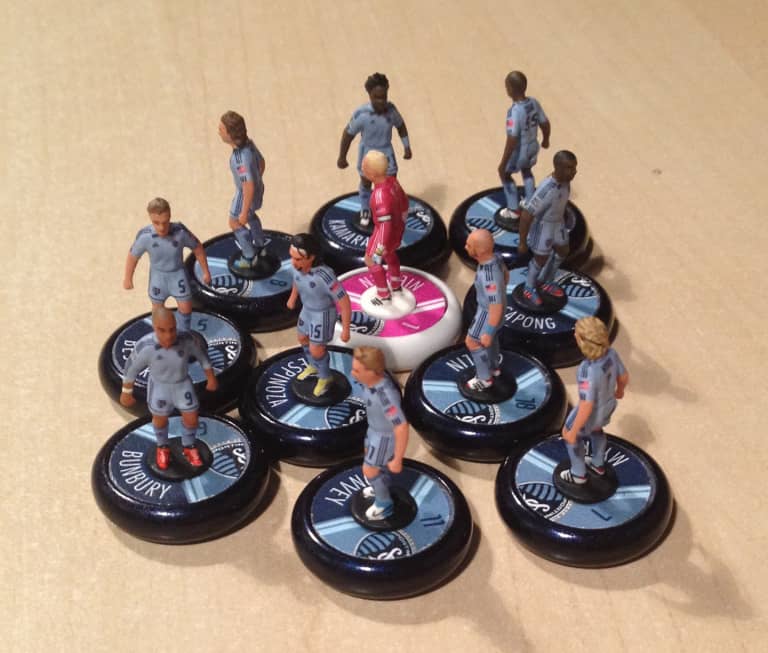
Drake's stadium replica and player pieces featuring SKC's 2012 squad; Photos courtesy of Jeff Drake
Drake also owns a sharp-looking set featuring the team’s blue-on-blue hoops from 2014, with pieces so detailed that the miniature Graham Zusi has a man-bun and the miniature Dom Dwyer has a faux-hawk.

Photo courtesy of Jeff Drake
He even has a vintage Kansas City Wizards-themed set with a frozen-gloriously-in-time rainbow motif.
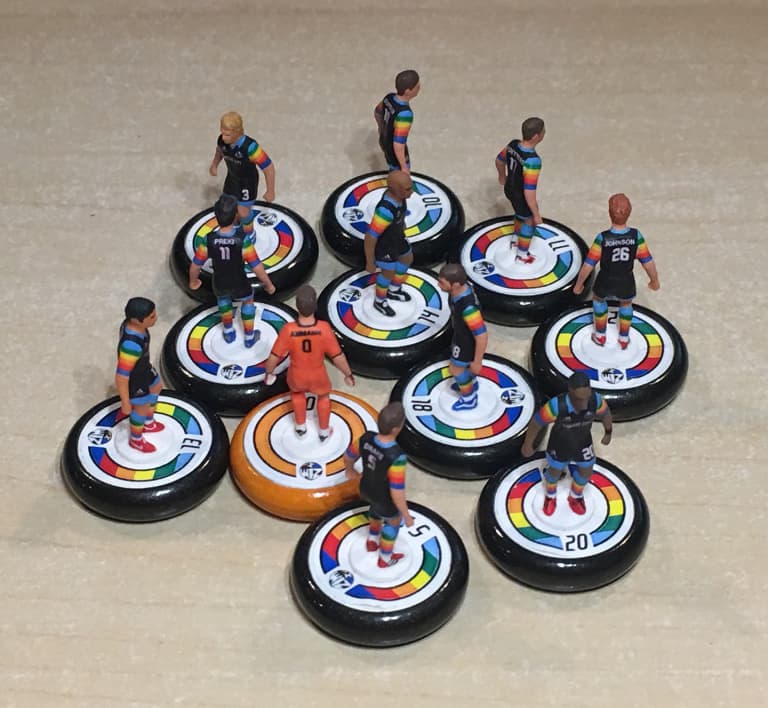
Photo courtesy of Jeff Drake
Drake is not only a soccer fan, you see — he’s also a Subbuteo fan.
Subbuteo (pronounced sub-BOO-tee-oh) is a soccer-derived tabletop game with a select, but dedicated, core of American fans. According to Subbuteo.com, the game (now trademarked by game-manufacturing giant Hasbro) was invented in 1947, with the name oddly coming from the creator’s love for falconry. (The scientific name for a type of falcon involved in that hobby is Falco subbuteo.)
At its core, Subbuteo — also known as “table soccer” in some circles — plays like soccer, with players trying to score as many goals as possible in a match by flicking the player pieces toward a plastic ball.
There are a few basic rules to keep in mind. A game is typically played in two fifteen-minute halves. Offense and defensive players take turns flicking player pieces around the field; when there’s a turnover, the player on defense switches to offense and vice versa.
Defenders can be flicked into the path of potential shots, but can’t actually make contact with the ball. Players can only shoot once the ball’s been crossed into the quadrant of the field closest to the goal, marked by a line — specific to Subbuteo pitches — halfway between the end line and the center line.
The Head of the American Subbuteo Association is Italian-born Dario Passadore, 47, who now lives in Boca Raton, Florida. According to him, the game is a fast-paced blend of soccer, pool, and chess, with manual dexterity a plus for anyone playing.
In fact it’s particularly popular abroad, and that’s indirectly how Drake got hooked – his childhood friend, Darren Koffman, brought home a set from Ireland in 1980. The latter likens it to “playing high-speed chess, where both players are making moves at the same time.”
And Therron Thomas, an Indianapolis-based player who favors two separate Indy Eleven teams when he plays, likens it to “chess while amped up on caffeine.”
“It’s a way to emulate your heroes who play on Saturday or Sunday,” Passadore says, noting that in Europe, the game’s more ingrained in their culture and easier to find than it is in North America.
Indeed, aficionados here reach out to Italian and English suppliers via the internet to buy custom bases, metal goals, rubber-bottomed pitches, and even starter game sets.
Chris Barron, a Dallas-based fan, estimates he’s spent $2000 on Subbuteo equipment while reviving his interest in the game. (How did the interest get re-sparked? By happening upon the childhood set that he, eerily just like Kauffman, bought in 1980 while visiting the British Isles.)
His purchases include five different pitches and nearly 20 different teams. That assortment includes a sheet of decals for an inaugural-year Sounders team he’s been meaning to affix to a mannequin-like set of faceless players.
“For a while, I had the boxes shipped to my office,” he says, laughing about his purchasing habit. “But then, the lady who works next to me ratted me out to my wife.”
Barron and fellow FC Dallas fan Jeremy Stroop head up the Lone Star Subbuteo League, which gets together for monthly games as schedules allow. They also occasionally bring a pitch out to Frisco’s Toyota Stadium to introduce Subbuteo to FC Dallas tailgaters.
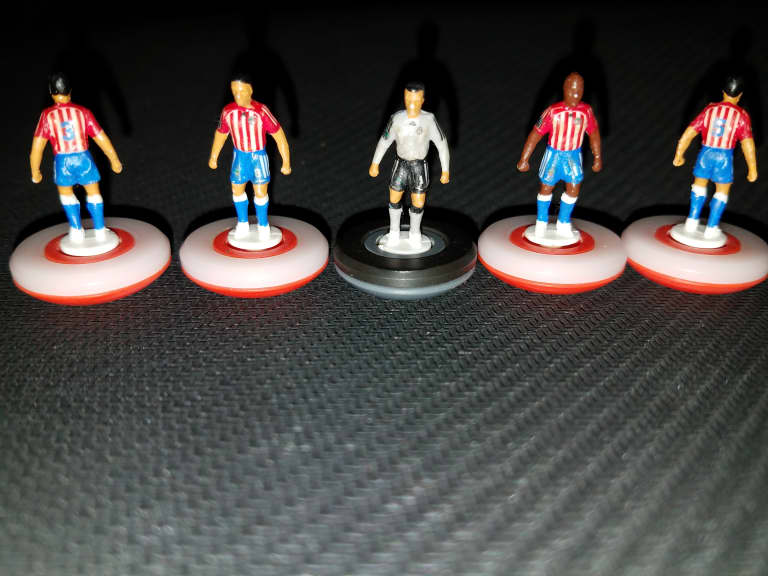
Stroop also occasionally plays with a Chivas USA-themed set. Photo courtesy of Jeremy Stroop
Barron and Stroop also count themselves as part of an interstate group of Subbuteo superfans, including Drake, Koffman, and Thomas. Together, they go by the unfortunate moniker MOIsT (for the members’ Missouri, Ohio, Indiana and Texas home bases).
Throughout the year, various members of the group host tournaments, which are guys’ weekends comprised of beer-drinking, Subbuteo-playing, and a field trip to see live soccer. When Barron or Stroop host an October or November event (“because it’s just wrong to ask people to come to Texas during the summer,” Stroop rightly says), it’s timed around an FC Dallas home game.
Other annual tournaments for the group include the Drake-hosted “Brick Tamland Celebrity Classic,” named for a deleted scene in Anchorman featuring Steve Carroll’s inimitable weatherman character hosting a golf tournament). There’s also a yearly Bloomington, Indiana pilgrimage they’ve christened “Flick Madness.”
The ASA — whose membership numbers have vacillated between 40 and 110 in recent years — also hosts official annual tournaments. Those include a round-robin championship between the “11 top US players” this coming August in Grand Rapids, Michigan.
The question of whether Subbuteo is for soccer fans or gaming fans is a matter of healthy debate. As blasphemous as it might sound, there are some Subbuteo players who don’t watch soccer at all, and appreciate the game for reasons disconnected from the sport it resembles.
Indeed, there are fundamental differences between soccer and Subbuteo, even though Subbuteo teams often look like soccer teams. For instance, soccer prizes midfield players who can connect the vast expanse between goal boxes, whereas in Subbuteo, it’s not unusual to line up with seven players in the back, with a mere trio of player pieces handling the offense.
Also, while Subbuteo players joke about getting winded running around a table, there is a different kind of physical prowess that they develop. Even the most rudimentary Google search will reveal YouTube videos that, while badly soundtracked, show physics-defying passes and shots that showcase the dexterity expert players develop.
It doesn’t require a love for soccer to play Subbuteo well. Barron notes that the current ASA reigning champion is actually a hockey fan who found similarities between Subbuteo and his angle-dependent, shoot-into-a-net sport of choice. But, as many Subbuteo fans will note, a love for soccer will only enhance the love of a game that more Americans could and should embrace.
“It’s tremendous fun and honestly, not terribly expensive,” Thomas says, stating a basic truth about the game, and yet willfully ignoring his own creation of a stadium or painstaking replication of his favorite team’s uniform.
“I think people who would really enjoy it are like me: gamers who are also soccer fans,” he says. And for those with a foot in both those worlds – maybe you’ve successfully settled Catan, thrown a spell in Dungeons & Dragons, or angled a puck past a sibling in a vicious game of air hockey — there’s a place for you in the Subbuteo universe. It’s as easy to find as an internet search, and a willingness to pay shipping charges.

